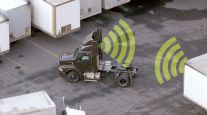Effective Driver Coaching: How In-Cab Technology Makes It Possible
Done correctly, driver coaching creates safer, more profitable routes. Transport Topics reports how Kriska leverages in-cab technology for driver improvement.
-
Regular driver coaching increases safety and fuel efficiency. In-cab technology gives better insights into driver performance, allowing supervisors to provide personalized feedback to each operator.
-
Additionally, front-facing cameras and telematics help to optimize fleet logistics and provide liability protection.
-
Kriska uses ISAAC Instruments to collect data for accident prevention and avoidance training. Safety and training supervisor Guy Broderick shares the methods behind the program’s success.
It’s no secret that fleet managers value safe, efficient operations. Yet even with GPS trackers, smartphone communication, and the occasional 10-4 on the CB radio, much of a driver’s on-route performance exists in a black box. Fleet supervisors lack the visibility to know exactly what’s happening when a vehicle suddenly speeds up or encounters a problem. To resolve this challenge, many companies have turned to in-cab video.
While some drivers may express concerns about “Big Brother” watching their every move, Ontario-based freight carrier Kriska has found tremendous success with its in-cab monitoring and driver coaching program. Not only have Kriska drivers embraced the added eyes and accountability, but the company is also seeing better safety and fuel efficiency metrics through its video-based driver instruction.
“We can take these videos and actually show people what they might have done right and what they might have done wrong,” said Kriska safety and training supervisor Guy Broderick.
To learn more about how this coaching program works, TT’s Seth Clevenger spoke with Broderick on the RoadSigns Podcast. Here’s what the conversation uncovered.
Efficiency metrics need the right technology
Trucks have used technology to monitor fuel efficiency for years. Many major transport companies use speed limiters on their vehicles and frequently employ GPS tracking devices to monitor speed, route changes, or stops.
Miles per gallon, however, can be a misleading metric when viewed in isolation. The terrain, the type of load, the equipment on the truck, and the tire quality can all contribute to fuel efficiency. But in Broderick’s experience, “A lot of it is based on how a driver drives,” he said.
Kriska uses in-cab video and telematics systems from ISAAC Instruments. The comprehensive software solution includes a forward-facing camera and precise monitoring of driver actions that contribute to vehicle performance. Instead of making a general observation about how fast a driver is going, the ISAAC coaching tool allows Kriska to provide specific feedback on operator decisions.
“The drivers are looking at the [gear] shifting and how hard they’re pushing on the accelerator,” Broderick explained. “We’ve seen positive results for it.”
Driver advocacy through personal improvement
To some, this kind of precise micromanagement can seem like an added stressor for drivers in what’s already a difficult career field. With more than half of drivers saying they evaluate carriers based on peer reviews, negative driver perceptions of an in-cab monitoring system could hinder recruitment and retention.
Although Broderick acknowledged he has encountered some reluctance toward the software among experienced drivers, the overwhelming majority of Kriska drivers embrace the system. New drivers attend an orientation where they learn about the coaching software, what it analyzes, and how it integrates with the truck’s engine control module.
“We don’t want to lie about anything,” Broderick said. “We don’t want to sugarcoat it. We just tell drivers, ‘The program’s here. We use it to monitor a whole list of items, and we need you to be within that list of items.’”
Some drivers come to see the reports as a sort of friendly competition — who can get the best efficiency score on the ISAAC SpeedGauge platform? Kriska also offers up to $100 per month in gift cards for each driver who scores within the bonus range.
The safety and efficiency score represents more than just a monetary incentive — it also offers a tool for career development. By looking back over months of data, drivers can see where they are making consistent mistakes and how small operational changes have led to dramatic improvements in their scores.
Broderick noted that having sophisticated software can help with the recruitment of younger drivers. “Trucking really does have some fascinating technology,” he added. “It’s a great way to bring young people into the industry.”
Keeping safety at the forefront
Speeding is the top infraction of commercial motor vehicle drivers, so rewarding slower, fuel-efficient driving already has built-in safety benefits. Additionally, the onboard camera provides further instructional opportunities, and Kriska educates its drivers early and often.
“It’s in our daily plan to look for risky behavior,” Broderick said. If the fleet safety department identifies a problem, they take quick action to speak with the driver.
“We will bring that driver in. We will sit them down and watch the videos with them,” Broderick said. “Then we’ll explain to them firsthand, ‘This is why what you’re doing is wrong. This is why what you’re doing can lead to an accident.’”
For many drivers, the message hits home when they see their view from behind the steering wheel. The added accountability can help them visualize the potential consequences of negligent driving. If the issue persists, Kriska can arrange for the driver to take another road test or require additional online training.
Of course, in many cases of a vehicle collision, the truck driver is not at fault. Video evidence not only supports the truck driver in an investigation but also shields the company from liability.
Broderick said that when an accident occurs, Kriska can pull the video and supply it to the responding law enforcement officer within 30 minutes. Often, the video changes the officer’s tone or even redirects the course of the inquiry.
“The next thing you know, that other driver’s being charged or it’s being investigated more on the other driver,” Broderick said.
Implementing a coaching system
For trucking companies considering a technology-driven coaching system, Broderick had two pieces of advice: Be transparent, and choose the right provider.
“You have to be honest with people,” he said. “You can’t hide the technology.”
From creating clear expectations at orientation to having regular constructive conversations, companies need to maintain an open dialogue with their drivers. Broderick encourages sharing wide data sets, such as showing the energy impact of extended idling, to make driver coaching educational and interesting, not just a reprimand for speeding. Done right, coaching is about the pursuit of excellence and being the best drivers on the road.
Next, Broderick encouraged carefully researching electronic logging device (ELD) manufacturers and understanding a provider’s full suite of technological capabilities before signing a contract. Adding cameras and ELDs to every vehicle in the fleet is a hefty upfront cost, and fleet managers should have confidence in the ongoing customer support process of their chosen technology partners.
“It’s a major investment,” Broderick said, “but it’s an investment that pays off.”
This article is based on an episode of RoadSigns, a podcast exploring the trends and technologies that are shaping the future of trucking. Check out the website to catch past and future episodes.




